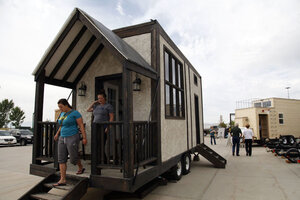How do you finance a tiny house?
Tiny homes, which typically are smaller than 500 square feet, can cost as little as $10,000 to build yourself or up to $100,000 through a professional. But regular-size homebuying rules still apply.

Brynna Brockback, left, and Leslie Kay, right, exit a model tiny house at a display outside the Cabela's in Lehi, Utah. The Tiny Home movement is a worldwide change in the way people use their living spaces.
Chris Samuels/The Daily Herald/AP/File
Like many recent college graduates, Ryan Mitchell was quickly overwhelmed by crushing student loan debt and the fact that half of his income was going straight to rent and utilities. Owning his own home? That seemed like a pipe dream.
That is, until he discovered big financial freedom in the form of a tiny house.
For just $30,000, Mitchell’s microscopic home on wheels provides him with just enough space to enjoy a simple lifestyle — and save big on monthly living costs. To get his project started, his parents lent him the initial $10,000 for a blank trailer and some windows — and, yes, they charged him interest.
Over the next 18 months, he worked, saved up and paid cash for the materials, and built his tiny house in stages. In the summer of 2014, he finally moved into his 150-square-foot custom tiny home in Charlotte, North Carolina. Since then, not only has he repaid his parents in full, he also saved up some serious cash — $3,000 per month — and shrank his monthly utility bill to just $15.
“Living in this tiny house lets me travel the world, gives me time to write a book and leave my full-time corporate job,” says Mitchell, who started TheTinyLife.com blog to document his journey and show others how to build their own tiny house. “It’s not about living in a tiny house but more about the lifestyle you want to have.”
Financing: RV loan vs. personal loan
Tiny homes, which typically are smaller than 500 square feet, can cost as little as $10,000 to build yourself or up to $100,000 through a professional builder, depending on size, amenities and features. No matter the house size, homebuyers still need to ask themselves: How much house can I afford?
You won’t find a traditional home loan for a tiny home because most mortgage lenders have minimum loan amounts and offer loans for homes on permanent foundations only, whereas a lot of tiny homes are built on trailers with wheels. However, you can finance directly through a builder or take out a personal loan or RV loan, says Todd Nelson, business development officer with LightStream, a lending division of SunTrust Bank that offers both personal and RV loans for tiny-house buyers.
For example, if you bought a tiny house with an RV loan through LightStream ranging from $25,000 to $49,999, you’d get an interest rate of 4.89% to 8.39% for a term of 73 to 84 months, depending on your credit. In order to obtain an RV loan, a tiny house must be certified by the Recreational Vehicle Industry Association to meet manufacturing and safety requirements proving it’s “roadworthy,” Nelson says.
If your tiny home isn’t association certified, or if you plan to put it on a foundation, you can take out an unsecured personal loan, Nelson adds, but the interest rate would be higher — 7.29% to 10.79%. “With an unsecured loan, it’s not collateralized. We’re underwriting the consumer, not the item, in that scenario,” he says.
Where do you put it?
Buying or building a tiny house has one more wrinkle that you have to figure out before you take the plunge. You’ll need somewhere to put it.
You have a few options: buying a parcel of land, parking on a friend’s or relative’s property, or, if your home is on wheels, moving it around public land (where permitted) or renting a long-term RV spot.
Buying land will add to your overall costs, and don’t forget about the property taxes. But to move your tiny house around, you’ll need a vehicle big enough to haul it and you’ll have to pay for trailer license plates and annual RV registration.
If you buy land, make sure there are no restrictions on what type of structures are allowed on it. The American Tiny House Association has compiled a list of state-by-state regulations for tiny houses.
Different from the norm, but worth it
Korie and Alex Veidel park their 144-square-foot home on wheels in Alex’s parents’ backyard outside Chicago. Faced with spending a minimum of $1,000 a month on rent on their modest salaries, the couple, both in their mid-20s and parents of a 9-month-old baby, decided to buy a pre-built tiny house through a local builder for $25,000 using their combined savings.
“Living here has its challenges, like having no privacy and hearing everything around you, but we also have more family time and are able to travel more,” Korie Veidel says.
“When we first got engaged, we considered the typical route of getting a mortgage and a bigger house. My father worked in real estate, and my family was hit hard during the downturn. That was eye-opening. I know a lot of people who lost their homes to foreclosure and were in debt. I didn’t want to go down that road.”
Deborah Kearns is a staff writer at NerdWallet, a personal finance website. Email: dkearns@nerdwallet.com. Twitter: @debbie_kearns.
This article was written by NerdWallet and was originally published by USA Today.

